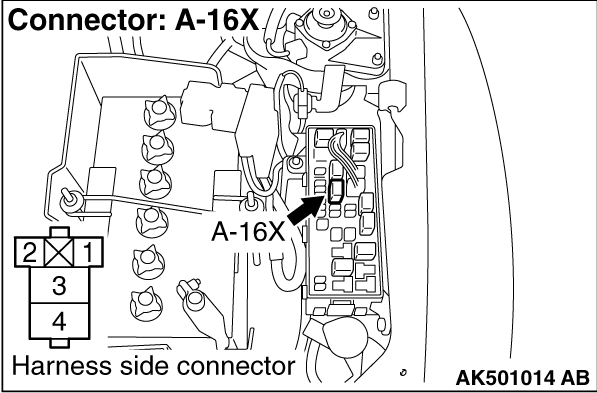|
|
- Measure battery voltage during cranking.
|
|
|
Q.
Is the check result normal?
|
|
|
 Check battery (Refer to GROUP 54A - Battery - On-vehicle Service - Battery
Test Check battery (Refer to GROUP 54A - Battery - On-vehicle Service - Battery
Test  ). ).
|
|
|
|
|
|
OK:
ON (Ignition switch: ST)
OFF (Ignition switch: ON)
|
|
|
Q.
Is the check result normal?
|


|
Q.
Are the check results normal?
 Go to Step 4 . Go to Step 4 .
 Repair or replace. Repair or replace.
|

|
- Disconnect connector, and measure at the harness side.
- Voltage between terminal No. 1 and earth.
OK: System voltage
Q.
Is the check result normal?
 Go to Step 5 . Go to Step 5 .
 Repair the harness wire. Repair the harness wire.
|


|
- Remove starter relay
- Disconnect A-110 starter connector
- Resistance between A-110 starter connector terminal No. 1 and A-16X starter relay
connector terminal No. 3.
OK: Continuity (2 Ω or less)
Q.
Is the check result normal?
 Check starter (GROUP 16 - Starting System - Starter Motor Assembly
Inspection Check starter (GROUP 16 - Starting System - Starter Motor Assembly
Inspection  ). ).
 Repair the harness wire. Repair the harness wire.
|
|
|
- Check starter relay itself (Refer to GROUP 16 - Starting System - On-vehicle
Service - Starter Relay Check
 ). ).
|
|
|
Q.
Is the check result normal?
|
|
|
 Replace the starter relay. Replace the starter relay.
|
|
|
|
|
|
- Check inhibitor switch itself (Refer to GROUP 23A - On-vehicle Service - Essential
Service - A/T Control Component Check - Inhibitor switch Check
 ). ).
|
|
|
Q.
Is the check result normal?
|
|
|
 Replace the inhibitor switch. Replace the inhibitor switch.
|
|
|
|

|
- Disconnect connector, measure the harness side.
- Voltage between terminal No. 2 and earth.
- Ignition switch: ST
OK: System voltage
Q.
Is the check result normal?
 Go to Step 9 . Go to Step 9 .
 Repair the harness wire. Repair the harness wire.
|

|
- Disconnect connector, measure the harness side.
- Resistance between terminal No. 1 and earth.
OK: Continuity (2 Ω or less)
Q.
Is the check result normal?
 Go to Step 10 . Go to Step 10 .
 Repair the harness wire. Repair the harness wire.
|

|
- Disconnect connector, measure the harness side.
- Voltage between terminal No. 4 and earth.
OK: System voltage
Q.
Is the check result normal?
 Go to Step 11 . Go to Step 11 .
 Repair the harness wire. Repair the harness wire.
|


|
Q.
Are the check results normal?
 Go to Step 12 . Go to Step 12 .
 Repair or replace. Repair or replace.
|

|
- Disconnect connector, and measure at the harness side.
- Ignition switch: ST
- Voltage between terminal No. 103 and earth.
OK: System voltage
Q.
Is the check result normal?
 Go to Step 13 . Go to Step 13 .

Check intermediate connector A-115, and repair
if necessary. If intermediate connector is normal, repair harness between A-16X (terminal No.
3) starter relay connector and C-103 (terminal No. 103) engine-ECU connector.
|
|
|
Q.
Does trouble symptoms persist?
|
|
|
 Replace the engine-ECU. When the engine-ECU is replaced, write the chassis number
(Refer to GROUP 00 - How to Perform Chassis Number Writing Replace the engine-ECU. When the engine-ECU is replaced, write the chassis number
(Refer to GROUP 00 - How to Perform Chassis Number Writing  ).
After replacing the engine-ECU, register the injector identification code and learn fuel injection (Refer
to GROUP 00 - Precautions Before Service - What The Common Rail Engine Learns ).
After replacing the engine-ECU, register the injector identification code and learn fuel injection (Refer
to GROUP 00 - Precautions Before Service - What The Common Rail Engine Learns  ). ).
|
|
|
|
|
|
 Intermittent malfunction (Refer to GROUP 00 - How to Use Troubleshooting/Inspection
Service Points - How to Cope with Intermittent Malfunction Intermittent malfunction (Refer to GROUP 00 - How to Use Troubleshooting/Inspection
Service Points - How to Cope with Intermittent Malfunction  ). ).
|
|
|
|
 Go to Step 2 .
Go to Step 2 . Go to Step 2 .
Go to Step 2 . Check battery (Refer to GROUP 54A - Battery - On-vehicle Service - Battery
Test
Check battery (Refer to GROUP 54A - Battery - On-vehicle Service - Battery
Test  ).
). Go to Step 3 .
Go to Step 3 . Go to Step 6 .
Go to Step 6 .

 Go to Step 4 .
Go to Step 4 . Repair or replace.
Repair or replace.
 Go to Step 5 .
Go to Step 5 . Repair the harness wire.
Repair the harness wire. Go to Step 7 .
Go to Step 7 . Replace the starter relay.
Replace the starter relay. Go to Step 8 .
Go to Step 8 . Replace the inhibitor switch.
Replace the inhibitor switch.
 Go to Step 9 .
Go to Step 9 . Repair the harness wire.
Repair the harness wire.
 Go to Step 10 .
Go to Step 10 . Repair the harness wire.
Repair the harness wire.
 Go to Step 11 .
Go to Step 11 . Repair the harness wire.
Repair the harness wire.

 Go to Step 12 .
Go to Step 12 . Repair or replace.
Repair or replace. Intermittent malfunction (Refer to GROUP 00 - How to Use Troubleshooting/Inspection
Service Points - How to Cope with Intermittent Malfunction
Intermittent malfunction (Refer to GROUP 00 - How to Use Troubleshooting/Inspection
Service Points - How to Cope with Intermittent Malfunction  ).
).